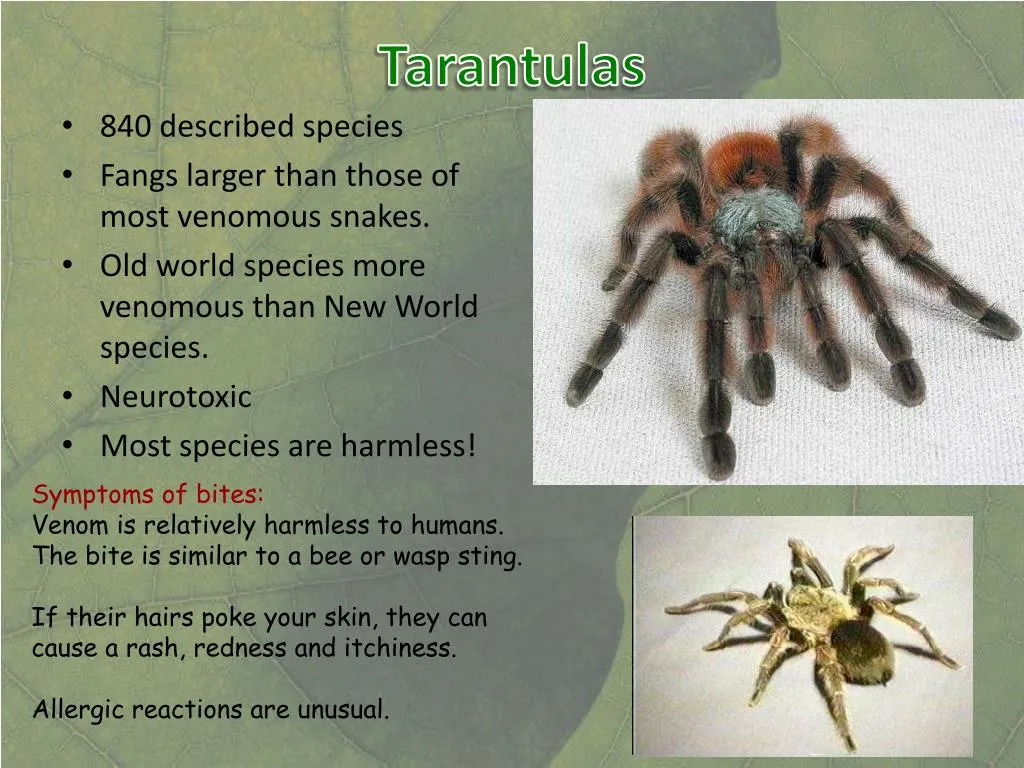Are Tarantulas Poisonous
The world of arachnids can be fascinating and, at times, intimidating. Tarantulas, with their imposing size and hairy appearance, often spark curiosity and concern. A common question that arises is whether these large spiders are poisonous. The answer, however, isn’t as straightforward as a simple yes or no. To understand the potential danger of a tarantula, we need to delve into the crucial distinction between venom and poison, the methods tarantulas use to subdue their prey, and the effects their bites can have on humans. This comprehensive guide will explore these aspects, providing a clear and informative perspective on tarantulas and their interaction with the world.
The Difference Between Venom and Poison
The terms ‘venom’ and ‘poison’ are often used interchangeably, but in the context of tarantulas, understanding the difference is crucial. This distinction determines how a substance affects living organisms and the way it is delivered. This is where we must clarify that the substance tarantulas use is venom, not poison.
What is Venom

Venom is a toxic substance that is actively injected into a victim through a bite or sting. It is a mixture of enzymes, proteins, and other compounds designed to incapacitate prey or defend against threats. Venomous animals, like tarantulas, have specialized delivery systems for injecting their toxins.
What is Poison
Poison, on the other hand, is a toxic substance that harms an organism when it is ingested, inhaled, or absorbed through the skin. Poisonous animals, such as certain frogs or plants, do not actively inject toxins. Instead, the toxins are present on the surface or within their bodies, causing harm through contact or consumption. Unlike venom, poison doesn’t require a delivery mechanism like fangs or stingers.
How Tarantulas Use Venom
Tarantulas are venomous creatures that use their venom primarily to subdue their prey, which includes insects, small rodents, and other invertebrates. Their venom is not typically potent enough to cause serious harm to humans, although the bite can be painful. The process by which tarantulas use their venom is a fascinating display of natural adaptation.
The Role of Fangs

Tarantulas possess large fangs, which are used to inject venom. These fangs are located at the front of the cephalothorax (the combined head and chest) and are designed to pierce the exoskeleton of their prey. The fangs act as the delivery system, channeling venom into the target.
Venom Delivery
When a tarantula bites, it uses its fangs to inject venom into its victim. The venom contains a complex mixture of toxins that have various effects. Some toxins paralyze the prey, while others begin the process of breaking down the prey’s tissues, making it easier for the tarantula to consume it. The delivery of the venom is a critical step in the tarantula’s predatory behavior.
Human Reaction to Tarantula Venom
While tarantula venom is not usually life-threatening to humans, it can cause a range of symptoms. The reaction varies depending on the species of tarantula, the amount of venom injected, and the individual’s sensitivity. Understanding the typical responses to a tarantula bite can help in managing the situation and seeking appropriate medical care.
Symptoms of a Tarantula Bite

Common symptoms of a tarantula bite include immediate pain at the site of the bite, redness, swelling, and itching. Some individuals may experience muscle cramps, nausea, and a general feeling of discomfort. In rare cases, more severe reactions, such as difficulty breathing or allergic responses, can occur, necessitating prompt medical attention. It is essential to monitor the bitten area and overall health after a bite.
Severity of Tarantula Bites
The severity of a tarantula bite is generally considered mild compared to bites from some other venomous creatures. The venom is designed for small prey, and the amount injected into a human is usually not enough to cause severe systemic effects. Most bites result in localized discomfort, which can be managed with basic first aid. However, individuals with allergies or other health conditions should be more cautious and seek medical advice if necessary.
Are All Tarantulas Poisonous to Humans
No, not all tarantulas pose the same level of threat to humans. The venom composition and potency can vary significantly between different species. Some tarantulas have venom that causes only mild irritation, while others may cause more pronounced symptoms. Furthermore, the size and strength of the tarantula’s fangs can also influence the severity of the bite.
Tarantula Species and Venom Potency

The potency of tarantula venom varies by species. For example, the venom of some Old World tarantulas (those found in Asia, Africa, and Australia) is often considered more potent than that of New World tarantulas (found in the Americas). However, even within the same region, venom potency can vary. Research and observation are ongoing to determine the precise effects of the venom from different species. Generally, the bite is not life-threatening to humans.
Factors Affecting Venom Toxicity
Several factors can affect the toxicity of tarantula venom. The amount of venom injected, the size and health of the individual bitten, and any existing allergies can all influence the severity of the reaction. The tarantula’s age and health also play a role, as these factors can affect the composition and potency of its venom. A bite from a stressed or defensive tarantula might also result in a more significant venom injection.
First Aid for Tarantula Bites
If bitten by a tarantula, it is essential to take immediate steps to address the situation and minimize potential complications. While most bites are not critical, proper first aid can help reduce pain and discomfort. This first-aid guide provides useful information.
What to Do Immediately

Firstly, stay calm and move away from the tarantula to avoid further bites. Clean the bite area gently with mild soap and water. Apply a cold compress to the bite site to reduce pain and swelling. Elevate the affected limb to help reduce swelling, and monitor yourself for any adverse reactions. If you experience significant symptoms, seek medical attention promptly.
When to Seek Medical Attention
Seek medical attention if you experience severe symptoms, such as difficulty breathing, dizziness, or signs of an allergic reaction. If you have any pre-existing medical conditions or concerns about the bite, it’s best to consult a healthcare professional. Also, if the bite area becomes infected or the pain worsens, seek immediate medical care. Your health and safety are paramount.
Debunking Common Myths About Tarantulas
Misconceptions about tarantulas often lead to unnecessary fear and misunderstanding. Addressing these myths with accurate information can help dispel unwarranted anxieties and promote a more informed perspective on these fascinating creatures. The following points address some common myths.
Myth 1: All Tarantulas are Deadly

The truth is that while tarantulas are venomous, their venom is rarely life-threatening to humans. Most bites result in mild symptoms that can be managed with basic first aid. The fear of tarantulas often stems from their appearance and size, leading to an exaggeration of their danger. However, fatalities from tarantula bites are extremely rare.
Myth 2: Tarantulas Can Jump Far
Contrary to a common belief, tarantulas cannot jump great distances. They are primarily ground-dwelling spiders and have limited jumping ability. Their movements are typically characterized by walking or running rather than jumping. This myth is perpetuated by their size and the fear they often evoke, but it is not based on factual evidence.
Conclusion
In conclusion, while tarantulas are venomous creatures, the risk they pose to humans is often overstated. Understanding the difference between venom and poison, the effects of a tarantula bite, and the appropriate first aid measures can help dispel unfounded fears and promote a more informed perspective. The vast majority of tarantula bites result in only mild, localized symptoms. By appreciating the facts about these remarkable spiders, we can better understand their role in the ecosystem and minimize unnecessary anxiety. Being well-informed allows for a more balanced view of tarantulas and their place in the natural world. It is essential to respect these creatures and handle them with caution, but also to avoid exaggerating their potential danger.
